Ultima IV was the first game of the series to get a better treatment on the IBM-PC, after the two previous ports were rather poor. However, the other ports of the game, despite being totally identical in game content, are also interesting to look at. This does not cover the Console Ports of Ultima IV, which are covered separately.
The Apple II Original[]
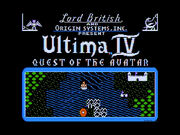
Apple II title screen
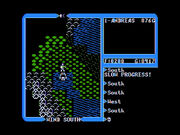
Apple II in-game
This is the original game, on which all the other ports are based on. The game has the full musical score, but needs a sound card to make use of it. For 1985, the graphics still look good, although they have to fight with several color problems (like purple colored brick floor). This version also has several glitches caused by the fact that it is the original.
The game came on two double-sided 5.25" floppy disks, making disk-swapping tolerable as they are divided into logical chunks (towns, dungeons...).
Note that a big issue was made of the fact that the game needed 64K RAM (even a sticker on the box), which in 1985 was a big issue as memory was expensive and the older Apple Models (before the Apple //e) never shipped with more than 48 KB factory-installed memory.
The C64-Port[]
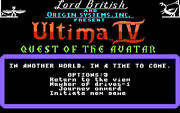
C64 title screen
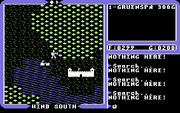
C64 in-game
The port for the C64 -made by Chuckles- looks graphically a lot like the original on the Apple II, although it does fix the color problems of the original (the brick floors are now red) and also has some graphical improvements. The dungeons however, are in monochrome and not in color (no big loss). The port also has the full musical score.
It was sold on two double-side 5.25" floppies. Thankfully, the division was logical and prevented excessive disk-swapping.
- Game (boot, character data, intro, extro)
- Towne (as name says, also castles and villages and all character conversations except for Lord British)
- Britannia (the overworld, plus conversation with Lord British)
- Dungeon (as name says)
However, the game came with no software fastloader, despite such software being available since late 1984, resulting in very long waits when the game has to load (even if it is only a conversation).
The Atari 8-bit Port[]
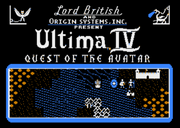
8bit title screen
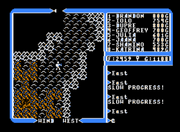
8bit in game
The port for the Atari 8-bit essentially is the same as the Apple II original. Origin utilized Atari's high resolution 320x192 graphics mode with 'artifacting' to provide color. Ultima 4 should detect the Atari system being played and adjust the colors to match the screenshots attached which are correct. They closely resemble the colors used on the Apple II version. In order to provide support to the majority of Atari users Origin only utilized 48k of ram which prevented adding the complete musical score. Like Ultima III the music is great at first but ultimately gets annoying. Basic sounds from the Apple were again ported. The was the last port of an Ultima game for the Atari 8bit computer series.
It was sold on two double-side 5.25" floppies. The same layout as the C64:
- Game
- Towne
- Britannia
- Dungeon
The 16-bit Ports[]
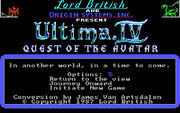
IBM-PC title screen
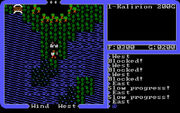
The wilderness
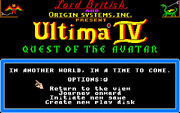
Amiga and Atari title screen
The 16-bit ports of Ultima IV are interesting. Unlike the last two parts, Ultima IV was the one where the ports for the Amiga, Atari ST and IBM-PC came much closer. Nonetheless there are obvious differences.
The PC-port was released in the same year as the original, made by James Van Artsdalen. It sports much improved graphics in EGA-graphics mode (a CGA mode for composite monitors was also available) over the 8-bit computer ports. However, it comes at the price of the music missing from this port. That's because there were no sound cards available for gamers until Adlib entered the market in early 1988. Only some sound effects from the PC-speaker are available. Thankfully, the Ultima IV Upgrade Patch re-inserts the music, beside a graphical update.
The IBM-PC port was sold on two 5.25" disks.
The ports for the Amiga and Atari ST were released three years after the original, which of course meant that there would be improvements over the PC-port. While both ports use the same graphics for the overworld, the dungeons look much nicer and realistic. Also both ports have a mouse-driven interface and the full musical score. Strangely, the title screen also looks different. The graphics for the intro were polished as well, since the PC-port has rather strange colors (yellow for skin for example). The Atari ST version has 6-channel midi music in addition to chip music.
Both ports are like identical twins, obviously because they were both made by "Banjo" Bob Hardy. Also both were sold on a single 3.5" floppy disk, eliminating disk swapping.
Japanese ports[]
The MSX port[]
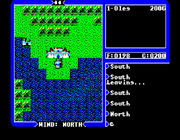
The MSX-port
There is also a port for this system. However, it was only released in Japan in 1987 and only exists in Japanese.
The game use a tileset that appears very similar to the Ultima I port. However much like this one it suffers from the same pixelisation issues, although not quite as much. It was released on two 3.5" disks. Other than that, it is a prefect copy of the original version, even using the same musics.
The MSX-Port of Ultima IV is very similar graphically and gameplay-wise to the PC 9801 release of Ultima IV included with the Japanese Ultima collection.
The FM-Towns port[]
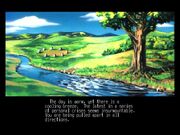
FM-Towns Introduction
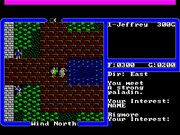
FM-Towns Ultima IV
The FM-Towns port of Ultima IV was released in Japan in 1992. While the FM-Towns was capable of handling high color 640x480 graphics, the designers chose to only update the introduction and endgame graphics. In-game graphics are a low quality copy of the 16-bit graphics released with Ultima V for the PC.
Of note, the game contained the entire soundtrack for Ultima IV in high quality CD-format. Other differences from the PC version consisted of an introduction screen allowing the player to choose to play in either English or Japanese. The title screen also allowed the player to review the story from Ultima III. The review contained high quality graphics not previously seen in an Ultima game.
| Computer Ports | |
|---|---|
| Games | Ultima I ☥ Ultima II ☥ Ultima III ☥ Ultima IV ☥ Ultima V ☥ Ultima VI |